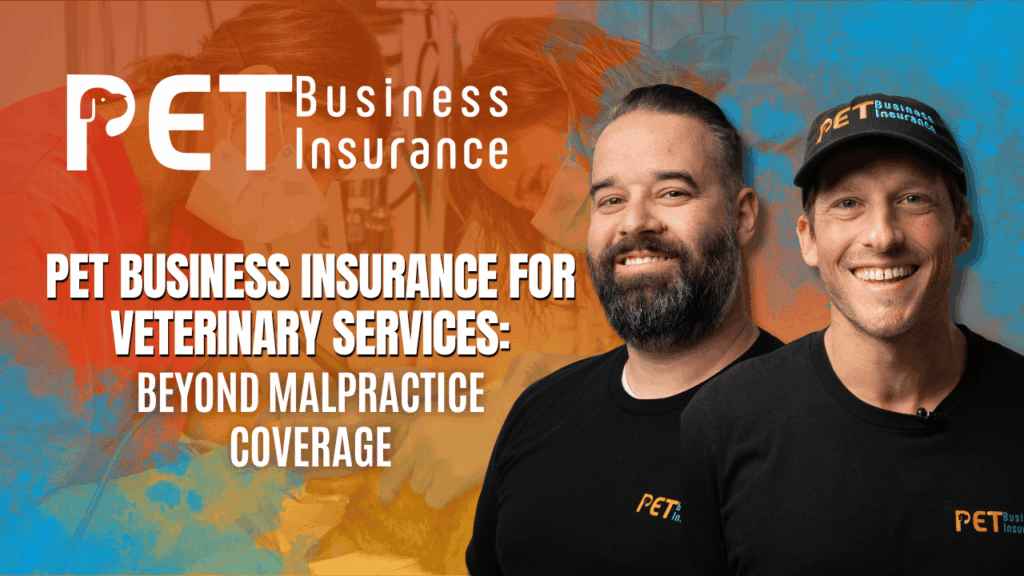
What’s putting your practice at risk beyond medical mistakes?
When most veterinarians think about protecting their business, they picture malpractice insurance. But what about the unexpected risks—like a cyberattack, a slip-and-fall in your lobby, or a missing pet during a routine visit?
In this article, you’ll learn the full scope of insurance protections your veterinary practice needs to truly stay safe and sustainable.
We’ll cover:
- The hidden risks that go far beyond malpractice
- The essential types of insurance for modern veterinary businesses
- Specialized coverages for different practice models
- How to build a truly comprehensive insurance strategy
Modern Veterinary Risks Go Far Beyond Malpractice
Today’s veterinary practices are sophisticated operations managing sensitive data, high-value equipment, and multi-person teams. Thinking malpractice coverage alone is enough can leave your business dangerously exposed.
Here’s a closer look at the bigger picture.
Property and Equipment Risks: Hidden Revenue Killers
Modern clinics house hundreds of thousands in high-tech tools—X-ray machines, surgical lasers, analyzers. Standard property insurance often doesn’t cover the internal failures that take these tools offline.
Equipment breakdown insurance fills that gap, covering electrical surges, mechanical breakdowns, and more. Combine that with business interruption coverage to protect your revenue while you recover.
Beyond Medical Mistakes: Liability Every Practice Needs
General Liability: Slip, Trips, and Bites
Think: a client trips in your waiting room, or a dogfight breaks out in your kennel. General liability insurance covers bodily injury or property damage claims—common, costly, and not covered by malpractice.
Animal Bailee: Coverage for Pets in Your Care
If a pet escapes, is injured during a walk, or dies in your care, most business policies won’t protect you. That’s where animal bailee insurance steps in, covering not only the pet’s value but search, advertising, boarding, and even rewards.
Protecting Your People: Workers’ Comp Is Critical
Veterinary teams face real danger—animal bites, heavy lifting, zoonotic disease. Workers’ compensation averages $0.93 per $100 of payroll, and specialized policies for vets often include:
- Rabies exposure treatment
- Volunteer and intern coverage
- Vet-specific claims management
Cybersecurity: A Modern Must-Have
You collect sensitive data: SSNs, payment info, medical records. A breach could cost you hundreds per record. Cyber liability insurance covers:
- Breach response costs (notifications, credit monitoring)
- Legal liability
- Ransomware and downtime recovery
Veterinary-specific risks include stolen laptops, compromised payment systems, and ransomware halting operations.
Internal Risk: Managing Staff and Leadership Exposure
EPL: Employment Practices Liability
One in five businesses will face a claim of harassment, discrimination, or wrongful termination. EPL insurance covers legal costs, settlements, and now often includes workplace violence protection and crisis support.
D&O: Directors and Officers Coverage
If you’re incorporated or have partners, D&O coverage protects leaders from claims related to mismanagement, fiduciary duty breaches, and more—exposures general liability doesn’t touch.
The Power of Umbrella Insurance
Umbrella liability adds $1–10 million in extra protection over your existing policies. With today’s litigation risks, it’s an affordable way to secure your practice against catastrophic losses from auto, liability, or malpractice claims.
Specialized Insurance for Unique Practice Models
Large Animal & Mixed Practices
Farm calls, mobile units, and valuable livestock demand tailored coverage—especially equipment protection and commercial auto policies.
Specialty and Emergency Clinics
High-risk procedures mean higher malpractice limits and custom endorsements for cutting-edge treatments are essential.
Corporate Veterinary Groups
If you have multiple locations or outside investors, you’ll need coordinated multi-location coverage, key person protection for leaders, and often D&O coverage at the corporate level.
Key Person Insurance: Protecting Your Practice’s Future
If a veterinarian generating $500K–$1M annually suddenly passes, the impact is enormous. Key person insurance replaces lost income, covers recruiting costs, and helps sustain operations or acquire competitors.
Risk Management: The Other Side of Protection
Leading insurers now offer loss control support, including:
- Staff safety training
- Claims prevention resources
- On-site inspections
Focus areas include:
- Animal handling protocols
- Detailed treatment documentation
- Emergency planning
Future-Proofing: What’s Next in Veterinary Insurance
As veterinary care evolves—think telehealth, AI tools, climate-related disruptions—insurance must keep pace. Practices are already seeing needs for:
- Broader business interruption coverage
- R&W coverage for acquisitions
- Global liability policies for expanding groups
How to Build a Comprehensive Insurance Plan
A strong veterinary insurance strategy includes:
- Core Coverage: General liability, professional liability, workers’ comp, commercial property and auto
- Specialty Add-ons: Equipment breakdown, animal bailee, enhanced malpractice
- Digital Risk: Cyber liability and data breach protection
- People Risk: EPL and D&O coverage
- Extra Protection: Umbrella insurance
- Continuity Planning: Key person and business interruption insurance
Conclusion: Protecting More Than Just Your License
Veterinary medicine today is about far more than clinical care. Your ability to serve clients depends on how well you protect your people, technology, and reputation from modern risks.
By thinking beyond malpractice and crafting a holistic insurance strategy, you protect what matters most—your team, your business, and your ability to deliver care.
Now that you understand what a truly comprehensive veterinary insurance program looks like, your next step is to speak with an insurance advisor who specializes in the veterinary industry. They’ll help you assess your specific exposures and build a strategy that scales with your goals.

